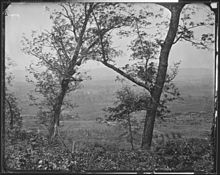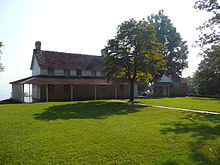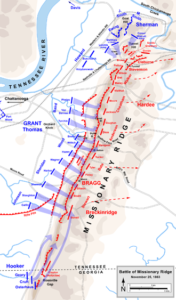The Battle of Missionary Ridge and the Confusion of Two Tunnel Hills
By: David Thomas
Things were beginning to improve for the Union Forces “trapped” in Chattanooga, Tennessee by mid-November 1863. General U. S. Grant had taken over command and appointing George H. Thomas as commander of the Army of the Cumberland (replacing William Rosecrans) and 15,000 men in two Corps under Major General Joseph Hooker arrived from the Army of the Potomac. These men helped break open the “cracker line” at the battles of Brown’s Ferry and Wauhatchie (October 27, 28 & 29, 1863). Moreover, 20,000 men of the Army of the Tennessee under General William T. Sherman just arrived from Vicksburg Mississippi.
With Sherman and his men joining the fray, Grant could now put his plan into motion. On November 23rd, Grant ordered Thomas to advance halfway to Missionary Ridge. These men captured the Orchard Knob Confederate outpost halfway between Chattanooga and Missionary Ridge. This movement caused Confederate General Bragg to adjust his defensive line. Sherman’s troops, meanwhile, were on the north side of the Tennessee River (opposite Missionary Ridge) ready to cross on the night of the 24th.

Orchard Knob in 1864
On the 25th , Grant sent Hooker’s command to demonstrate against Confederate troops on Lookout Mountain. Joseph Hooker had greater plans, advancing up the mountain from the Lookout Valley side, and defeated the Confederates around the Craven’s House. Fearing that Hooker would capture the only road off Lookout Mountain, the Confederates retreated to join Bragg’s force on Missionary Ridge.

Cravens house on Lookout Mountain
Grant’s plan for taking Missionary Ridge involved Sherman attacking the Ridge from the north end, while Hooker was to cross the Valley between Lookout Mountain and attack the Ridge from the South. Sherman and Hooker were to fight their way the length of the Ridge towards each other. The Army of the Cumberland was to take the enemy rifle pits at the center of the base of the Ridge and go no farther.
Hooker’s troops became bogged down in marshlands marching from Lookout to the Ridge and arrived late. Sherman ran into the hard fighting Confederate General Patrick Cleburne defending the northern end of Missionary Ridge. Cleburne’s men kept Sherman off the northern end of the Ridge.
For their part, Thomas’ Army of the Cumberland advanced, taking the Confederate rifle pits at the base of the Ridge and halted. With shells raining down on them and no orders, the men realized they needed to with draw or advance up the steep ridge. They broke the center of Bragg’s line and captured Missionary Ridge.
Now what about Tunnel Hill? At the northern end of Missionary Ridge where Cleburne held back Sherman the East Tennessee & Virginia Railroad passes under Missionary Ridge through a tunnel. This section of Missionary Ridge that Cleburne defended was known as “Tunnel Hill” (see map). While the overall fighting referred to as the Battle of Missionary Ridge, some accounts in the Official Records of the War of Rebellion mention the fight between Cleburne and Sherman as the “Tunnel Hill Battle” leading some to believe that this action took place at Tunnel Hill, Georgia.
That would be historically and logistically impossible. First, on November 25th both Union and Confederate armies are in Chattanooga, not North Georgia. November 25th is the date of the Battle of Missionary Ridge in Chattanooga. Second, one has only to study the time line: Bragg loses Missionary Ridge on November 25 and begins a full retreat to Dalton, Georgia on the morning of the 26th.

Battle of Missionary Ridge, November 25, 1863
Confederate – RED
Union – BLUE
On November 27th ,outside of Ringgold, Georgia, Confederate General Cleburne fights, defeats, and delays Joseph Hooker’s pursuing Union troops who are trying to catch and capture Bragg’s retreating army. Cleburne’s stand and victory allows Bragg’s army and wagon trains to safely reach Dalton. After the Battle of Ringgold Gap, Cleburne withdraws to Tunnel Hill, Georgia. The Union stops their pursuit at Ringgold, and the Battles for Chattanooga are over. So, while there were three different battles at and around Tunnel Hill Georgia, Sherman vs Cleburne on November 25th 1863 was not one of those.





